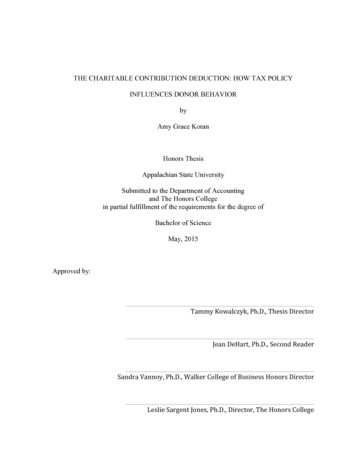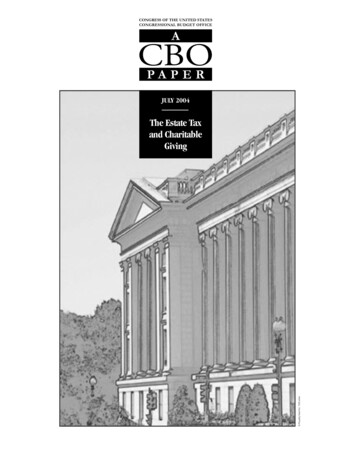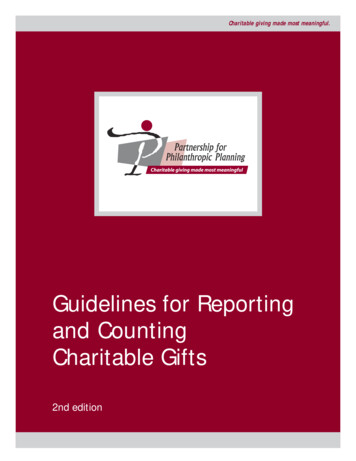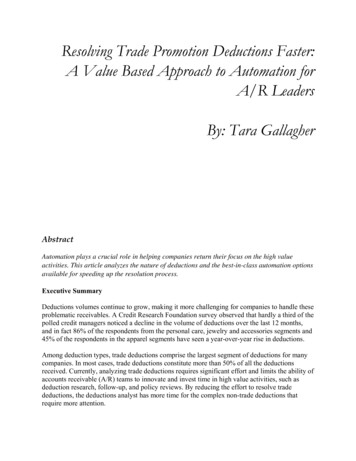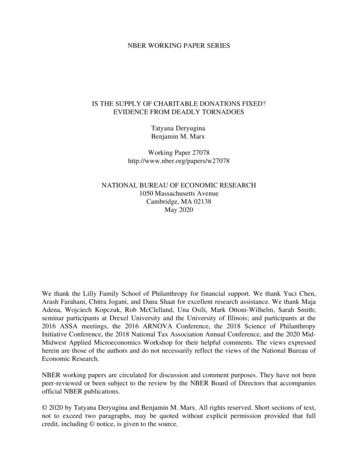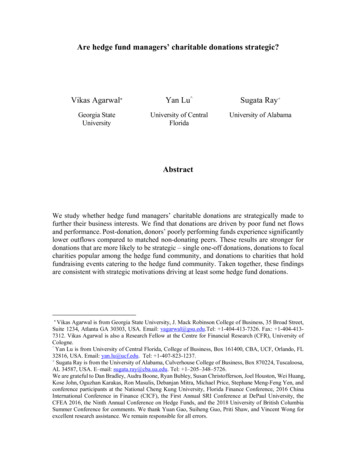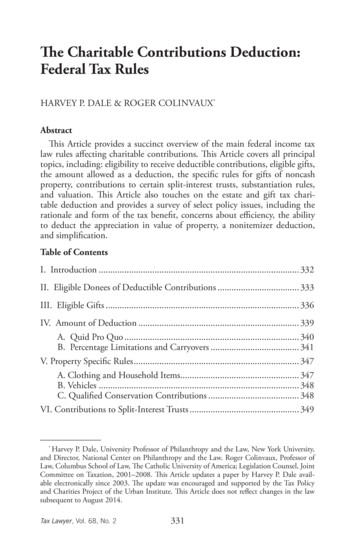
Transcription
THE CHARITABLE CONTRIBUTIONS DEDUCTION331The Charitable Contributions Deduction:Federal Tax RulesHARVEY P. DALE & ROGER COLINVAUX*AbstractThis Article provides a succinct overview of the main federal income taxlaw rules affecting charitable contributions. This Article covers all principaltopics, including: eligibility to receive deductible contributions, eligible gifts,the amount allowed as a deduction, the specific rules for gifts of noncashproperty, contributions to certain split-interest trusts, substantiation rules,and valuation. This Article also touches on the estate and gift tax charitable deduction and provides a survey of select policy issues, including therationale and form of the tax benefit, concerns about efficiency, the abilityto deduct the appreciation in value of property, a nonitemizer deduction,and simplification.Table of ContentsI. Introduction. 332II. Eligible Donees of Deductible Contributions. 333III. Eligible Gifts. 336IV. Amount of Deduction. 339A. Quid Pro Quo. 340B. Percentage Limitations and Carryovers. 341V. Property Specific Rules. 347A. Clothing and Household Items. 347B. Vehicles. 348C. Qualified Conservation Contributions. 348VI. Contributions to Split-Interest Trusts. 349*Harvey P. Dale, University Professor of Philanthropy and the Law, New York University,and Director, National Center on Philanthropy and the Law. Roger Colinvaux, Professor ofLaw, Columbus School of Law, The Catholic University of America; Legislation Counsel, JointCommittee on Taxation, 2001–2008. This Article updates a paper by Harvey P. Dale available electronically since 2003. The update was encouraged and supported by the Tax Policyand Charities Project of the Urban Institute. This Article does not reflect changes in the lawsubsequent to August 2014.Tax Lawyer, Vol. 68, No. 2331
332SECTION OF TAXATIONVII. Substantiation. 352A. Contributions of Less than 250. 354B. Contributions of 250 or More. 354C. Noncash Contributions of More than 500. 355D. Donee Obligations. 356VIII. Valuation. 356IX. Estate and Gift Tax Charitable Deductions. 357X. Policy Issues. 358A. Rationale and Form of the Tax Benefit. 359B. Efficiency Concerns. 362C. Deduction for the Appreciated Value of Property. 364D. Nonitemizer Deduction and Simplification. 3651. Nonitemizer Deduction. 3652. Simplification. 366XI. Conclusion. 366I. IntroductionThe United States has allowed an income tax deduction1 to individual andcorporate donors2 for charitable contributions since 1917.3 In the typicalcase—a donation of cash to a public charity—the donor may deduct theamount of cash donated.4 The amount of the deduction generally may notexceed, in the case of an individual, 50% of the individual’s “contributionbase,”5 or in the case of a corporation, ten percent of its taxable income.6Even slight deviations from the plain vanilla situation, however, may callinto play a variety of complex rules with the potential to change the amountof, or even wholly to deny, the charitable contributions deduction. Theserules depend on the form of the gift, whether the gift is of cash or property,the type of property donated, and the nature of the donee organization.1A charitable deduction also is allowed for estate and gift tax purposes. See I.R.C. §§ 2055,2522. This Article focuses on the income tax deduction but also briefly describes the estate andgift tax rules. See infra text accompanying notes 185-197.2Donations by partnerships, S corporations, and certain other pass-through entities areallowed to the partners, shareholders, etc., rather than being allowed to the entity. See, e.g.,§§ 702(a)(4), 703(a)(2)(C), 1366(a)(1). Charitable donations by trusts or estates are subjectto a different regime under section 642(c).3War Revenue Act, Pub. L. No. 65-50, § 1201(2), 40 Stat. 300, 330 (1917). The federalincome tax was enacted four years earlier.4See I.R.C. § 170(a)(1).5§ 170(b)(1)(A). An individual’s “contribution base” is his or her adjusted gross incomecomputed without any net operating loss carrybacks. § 170(b)(1)(G).6§ 170(b)(2); see infra note 82.Tax Lawyer, Vol. 68, No. 2
THE CHARITABLE CONTRIBUTIONS DEDUCTION333This Article provides a succinct overview of the main federal tax law rulesaffecting charitable contributions.7 This Article covers all principal topics,including: eligibility to receive deductible contributions, eligible gifts, theamount allowed as a deduction, the specific rules for gifts of noncash property, contributions to split-interest trusts, substantiation rules, and valuation.This Article also touches on the estate and gift tax charitable deduction andprovides a survey of select policy issues.II. Eligible Donees of Deductible ContributionsIt is often said that gifts to organizations, as defined in section 501(c)(3),are eligible for the charitable contributions deduction.8 That statement, however, is both over- and under-inclusive. It is over-inclusive because gifts toorganizations that test for public safety are not eligible for the deductioneven though such organizations are listed in section 501(c)(3).9 It is underinclusive because the section allowing the deduction—section 170(c)—mentions five types of eligible donee entities, only one of which is closely similarto those described in section 501(c)(3).Nevertheless, by far the most important class of eligible donees is describedin section 170(c)(2)(B), the words of which are closely similar to, but notidentical to, the words of section 501(c)(3). This class comprises entities“organized and operated exclusively for religious, charitable, scientific, literary, or educational purposes, or to foster national or international amateur sports competition . . . , or for the prevention of cruelty to childrenor animals.”10 For such entities to be eligible to receive tax-deductible gifts,additional statutory criteria must be satisfied:7A helpful publication is also available from the Service: IRS, IRS Pub. No. 526, Charitable Contributions (2013), available at -Contributions-1.8For example, in Bob Jones University v. United States, Justice Powell, concurring, wrote:“Federal taxes are not imposed on organizations ‘operated exclusively for religious, charitable,scientific, testing for public safety, literary or educational purposes . . . .’ 26 U.S.C. § 501(c)(3). The Code also permits a tax deduction for contributions made to these organizations.§ 170(c).” 461 U.S. 574, 606 (1983); see also Regan v. Taxation with Representation of Wash.,461 U.S. 540, 543 (1983) (“Taxpayers who contribute to § 501(c)(3) organizations are permitted by § 170(c)(2) to deduct the amount of their contributions on their federal income taxreturns . . . .”).9Rev. Rul. 65-61, 1965-1 C.B. 234; G.C.M. 32,399 (Sept. 21, 1962), modified by G.C.M.32,519 (Feb. 20, 1963); § 170(c)(2)(B) (omitting public safety organizations but includingother organizations described in section 501(c)(3)).10§ 170(c)(2)(B). The quoted language is identical to that in section 501(c)(3) with theexception that organizations that test for public safety are included in the latter but not in theformer. See supra text accompanying note 8.Tax Lawyer, Vol. 68, No. 2
334SECTION OF TAXATION The entity must be created or organized within the United States or itspossessions,11 The entity must not permit proscribed inurement of benefits toinsiders,12 The entity must not engage in political campaign activity,13 and The entity must not engage in substantial lobbying.14Further, although not an explicit statutory requirement, the entity must notviolate fundamental public policy, per the United States Supreme Court’sdecision in Bob Jones University.15No income tax charitable contributions deduction is allowed unless thecharitable donee is organized within the United States.16 This limitation issubject to two important qualifications. First, eligible U.S. charitable doneesmay use their funds abroad for charitable purposes.17 Second, a donor maydonate to a U.S. charity that, in turn, donates to a foreign charity.18 However,the Service has denied deductions in such a case if the intermediate U.S.charity is a mere conduit, that is, if “the domestic organization is only nominally the donee,” but “the real donee is the ultimate foreign recipient.”19 The11Section 170(c)(2)(A) states that the donee must be “created or organized in the UnitedStates or in any possession thereof, or under the law of the United States, any State, the Districtof Columbia, or any possession of the United States.” This restriction derives from 1935legislation affecting corporate donations (section 102(c) of the Revenue Act of 1935, Pub. L.No. 74-407, 49 Stat. 1014, 1016 (1935), adding a new section 23(r) to the Revenue Act of1934), and 1938 legislation affecting individual donations (section 23(o) of the Revenue Actof 1938, Pub. L. No. 75-554, 52 Stat. 447, 463 (1938)).12§ 170(c)(2)(C). For a critique of conditioning the deduction on the nondistribution constraint see Anup Malani & Eric A. Posner, The Case for For-Profit Charities, 93 Va. L. Rev. 2017(2007). But see Brian Galle, Keep Charity Charitable, 88 Tex. L. Rev. 1213 (2010) (refutingcritique).13§ 170(c)(2)(D); Reg. § 1.170A-1(j)(5)(ii).14§ 170(c)(2)(D); Reg. § 1.170A-1(j)(5)(i).15Bob Jones Univ. v. United States, 461 U.S. 574 (1983). For a discussion of the limitationsof the public policy doctrine see Johnny Rex Buckles, Reforming the Public Policy Doctrine, 53U. Kan. L. Rev. 397 (2005). These and other rules relating to the charitable deduction andtax exemption are discussed in Staff of J. Comm. on Taxation, 109th Cong., Historical Development and Present Law of the Federal Tax Exemption for Charities andOther Tax-Exempt Organizations (Comm. Print 2005).16See § 170(c)(2)(A).17The legislative history to the 1938 legislation (see supra note 11) explicitly confirmed this.H.R. Rep. No. 75-1860, at 19 (1938). Treasury regulations state that “all, or some portion, ofthe funds of the [donee] organization may be used in foreign countries for charitable or educational purposes.” Reg. § 1.170A-8(a)(1). For inexplicable reasons, however, U.S. corporatedonors are only allowed a deduction for donations to a U.S. corporate charity (as opposed to anoncorporate trust, community chest, or fund) if that domestic charity in turns uses its fundsabroad. § 170(c)(2); Rev. Rul. 69-80, 1969-1 C.B. 65.18See Rev. Rul. 63-252, 1963-2 C.B. 101 (examples 4 and 5); see also Rev. Rul. 66-79,1966-1 C.B. 48; Rev. Rul. 69-80, 1969-1 C.B. 65; Rev. Rul. 75-65, 1975-1 C.B. 79.19See Rev. Rul. 63-252, 1963-2 C.B. 101 (examples 1, 2, and 3).Tax Lawyer, Vol. 68, No. 2
THE CHARITABLE CONTRIBUTIONS DEDUCTION335deduction nevertheless may be allowed even if the intermediate U.S. doneegives funds only to a particular named foreign entity;20 such U.S. intermediate entities are sometimes called “friends of ” organizations because they arefrequently so named.21 The intermediate donee must not be bound, by anycharter or bylaw provision, to deliver the funds to the foreign organization;gifts by the intermediate donee to the foreign organization must be withinthe mission and purpose of the U.S. intermediate entity; and the U.S. intermediate organization must exercise some appropriate level of scrutiny overthe foreign donee to make sure that it qualifies as an eligible organization.22The place-of-organization limitation does not apply for purposes of thegift tax or estate tax.23 The Code, however, generally requires section 501(c)(3) organizations (other than certain religious groups or very small organizations) to notify the Service and to apply for a determination letter confirmingtheir section 501(c)(3) status within 27 months of their organization.24 Thisrequirement applies to foreign organizations unless they derive less than 15%of their “support”25 from U.S. sources.26 A foreign organization that is notexcused from this requirement but that fails to comply with it is not “treatedas an organization described in section 501(c)(3),”27 and donors to it may bedenied gift tax and estate tax charitable contributions deductions for theirgifts.28Rev. Rul. 66-79, 1966-1 C.B. 48; see also Rev. Rul. 74-229, 1974-1 C.B. 142.See, e.g., Judith S. Ballan, How to Aid a Foreign Charity Through an “American Friends of ”Organization, 23 N.Y.U. Conf. Tax Plan. for Section 501(c)(3) Org’s ch. 4 (1994).22See generally Harvey P. Dale, Foreign Charities, 48 Tax Law. 657, 659-63 (1995); KimberlyS. Blanchard, U.S. Taxation of Foreign Charities, 8 Exempt Org. Tax Rev. 719, 726 (1993).23Sections 2055(a)(2), 2055(a)(3), and 2522(a)(2) lack the restrictive language of section170(c)(2)(A). The gift tax regulations confirm that “[t]he deduction is not limited to gifts foruse within the United States, or to gifts to or for the use of domestic corporations, trusts, community chests, funds, or foundations . . . .” Reg. § 25.2522(a)-1(a). The estate tax regulations,in almost identical language, agree. Reg. § 20.2055-1(a). The charitable contributions deduction allowed to estates and complex trusts, per section 642(c)(1), is also “determined withoutregard to [the place-of-formation limitation in] section 170(c)(2)(A).” The regulations againconfirm this. Reg. § 1.642(c)-1(a)(2).24Section 508(a) mandates the notice requirement. Regulation section 1.508-1(a)(2)(i) prescribes the use of Form 1023 and states that it must be filed within 15 months from the endof the month of organization. Section 4.01 of Revenue Procedure 92-85, 1992-2 C.B. 490,grants an automatic 12-month extension of this 15-month time period.25For this purpose, “support” includes gifts, grants, contributions, membership fees, grossreceipts from admissions or sales or furnishing facilities, and net income from unrelated business activities but does not include “gross investment income.” I.R.C. §§ 4948(b), 509(d),509(e). Gifts, grants, contributions, and membership fees paid by U.S. persons are treated asfrom U.S. sources. Reg. § 53.4948-1(b).26§ 4948(b); Reg. § 53.4948-1(b). Under certain circumstances, even such excepted foreigncharities may cease to be eligible to receive donations that are deductible for gift and estate taxpurposes if they engage in a “prohibited transaction” and the Commissioner so notifies them.§ 4948(c); Reg. § 53.4948-1(c)-(d).27I.R.C. § 508(a).28§§ 508(d)(2)(B), 2055(e)(1), 2522(c)(1).2021Tax Lawyer, Vol. 68, No. 2
336SECTION OF TAXATIONBecause it may be difficult for potential donors to ascertain whether aprospective donee satisfies all of these conditions for eligibility, the Servicepublishes online a list of eligible donees and updates it regularly.29 Donorsmaking gifts in reliance on that published list, as modified by occasional public announcements by the Service, are generally protected even if the doneeorganization ceases to qualify.30Donees eligible to receive deductible contributions other than section170(c)(2)(B) organizations are (1) states, possessions, political subdivisions,and the District of Columbia, (2) posts or organizations of war veterans,(3) domestic fraternal societies, and (4) cemetery companies. Further conditions on eligibility are imposed for each type.31III. Eligible GiftsA deduction is allowed for a “charitable contribution.” A “charitable contribution” is defined as “a contribution or gift to or for the use of ” an eligible organization.32 There is no statutory definition of “contribution or gift.”Some early court decisions borrowed a definition from another part of thetax law,33 following a United States Supreme Court decision that describeda “gift” for those purposes as a transfer proceeding from “detached and disinterested generosity.”34 This line of authority, however, fell into disfavor, inpart because of its reliance on the subjective intent of the transferor–donor.35Preferring to focus on objective factors, the United States Supreme Court, inUnited States v. American Bar Endowment, articulated the test as follows: “The29IRS Publication 78, Cumulative List of Organizations Described in Section 170(c) of theInternal Revenue Code, lists all eligible charities on the Service Master File. The publicationis available and may be searched on the Service’s website at rganizations-Select-Check, but is not separately published as a paperversion.30See Rev. Proc. 2011-33, 2011-25 I.R.B. 887 for a general discussion of the extent towhich such reliance will be protected. The Service reserves the right to challenge deductions,even if the donee organization was listed in IRS Publication 78, if the donor knew of the revocation of the charity’s exempt status, was aware that it was imminent, or was in part responsiblefor or aware of the actions giving rise to the revocation. Id. § 3.01.31I.R.C. § 170(c).32§ 170(c).33§ 102.34Commissioner v. Duberstein, 363 U.S. 278, 286 (1960); see also DeJong v. Commissioner, 309 F.2d 373 (9th Cir. 1962) (applying the subjective Duberstein test).35See, e.g., Singer Co. v. United States, 449 F.2d 413 (Ct. Cl. 1971) (declining to apply theDuberstein test).Tax Lawyer, Vol. 68, No. 2
THE CHARITABLE CONTRIBUTIONS DEDUCTION337sine qua non of a charitable contribution is a transfer of money or propertywithout adequate consideration.”36Treasury regulations adopted in 1996 now state that no transfer will betreated as “a contribution or gift” unless the donor “[i]ntends to make a payment in an amount that exceeds the fair market value of the goods or services[received in exchange for the payment]” and “makes a payment in an amountthat exceeds the fair market value of the goods or services.”37 The second legof that test is purely objective; the first leg derives from a sentence in AmericanBar Endowment in which the United States Supreme Court said, “A payment of money generally cannot constitute a charitable contribution if thecontributor expects a substantial benefit in return.”38 However, because of thesubstantiation requirements discussed below,39 the first leg of the test does nothave much practical significance.Charitable gifts must be made either “to” or “for the use of ” an eligibledonee; this distinction affects the deduction limitation for an individualdonor and is discussed further below.40 Gifts must be complete and unconditional to qualify for a deduction: retention of control by the donor, or theexistence of conditions that might defeat the gift, may postpone or preventdeductibility.41 The Treasury regulations state the test:36477 U.S. 105, 118 (1986). Three years later, the Court commented approvingly on theAmerican Bar Endowment objective test saying, “This practice has the advantage of obviatingthe need for the IRS to conduct imprecise inquiries into the motivations of individual taxpayers.” Hernandez v. Commissioner, 490 U.S. 680, 690-91 (1989); see also Rolfs v. Commissioner, 668 F.3d 888, 891 (7th Cir. 2012) (noting that “[t]he IRS and the courts look to theobjective features of the transaction, not the subjective motives of the donor”). See generallyDouglas A. Kahn & Jeffrey H. Kahn, “Gifts, Gafts, and Gefts”—The Income Tax Definition andTreatment of Private and Charitable “Gifts” and a Principled Policy Justification for the Exclusionof Gifts from Income, 78 Notre Dame L. Rev. 441, 495-524 (2003).37Reg. § 1.170A-1(h)(1), adopted by T.D. 8690, 1997-5 I.R.B. 5. The Service took thisposition in rulings prior to adoption of the regulations. See, e.g., Rev. Rul. 67-246, 1967-2C.B. 104; Rev. Rul. 68-432, 1968-2 C.B. 104.38477 U.S. at 116 (emphasis added).39See infra text accompanying notes 144-164.40See infra text accompanying notes 67-72.41See, e.g., Briggs v. Commissioner, 72 T.C. 646 (1979) (conditions on donated propertynot negligible; held: deduction denied), aff’d without opinion, 665 F.2d 1051 (9th Cir. 1981);885 Inv. Co. v. Commissioner, 95 T.C. 156 (1990) (court found it “doubtful” that conditionon use of donated property would be met; held: deduction denied); Rev. Rul. 73-1, 1973-1C.B. 117 (donor’s retained option to require repayment of donated amounts fatal to deduction); Rev. Rul. 77-305, 1977-2 C.B. 72 (donor’s power to compel donee to sell donated property and accept cash instead fatal to deduction); see also United States v. Dean, 224 F.2d 26, 29(1st Cir. 1955). See generally Johnny Rex Buckles, The Case for the Taxpaying Good Samaritan:Deducting Earmarked Transfers to Charity Under Federal Income Tax Law, Theory and Policy,70 Fordham L. Rev. 1243 (2002); John McGown, Jr., Major Charitable Gift—How MuchControl Can Donors Keep and Charities Give Up?, 91 J. Tax’n 279 (1999); Ronald W. Blasi &Richard A. Denesha, Avoiding Disallowance of Earmarked Charitable Contributions, 9 Rev.Tax’n Individuals 160 (1985).Tax Lawyer, Vol. 68, No. 2
338SECTION OF TAXATIONIf as of the date of a gift a transfer for charitable purposes is dependentupon the performance of some act or the happening of a precedent event inorder that it might become effective, no deduction is allowable unless thepossibility that the charitable transfer will not become effective is so remoteas to be negligible.42Designations of particular purposes for gifts or imposition of conditions thatare extremely unlikely to interfere with the donee’s interests are not fatal43 butmay affect valuation of the gift and so the amount of the deduction.44Gifts of less than the donor’s entire interest in the property donated do notqualify for a charitable contributions deduction.45 There are five exceptionsto this rule:1. Gifts of remainder interests in charitable remainder trusts,462. Gifts of lead interests in charitable lead trusts,4742Reg. § 1.170A-1(e); accord Reg. § 1.170A-7(a)(3). The quoted language leaves room,however, for certain conditions so long as the likelihood of their occurrence is deemed “soremote as to be negligible.” The Regulation goes on to confirm this:If an interest in property passes to, or is vested in, charity on the date of the gift andthe interest would be defeated by the subsequent performance of some act or the happening of some event, the possibility of occurrence of which appears on the date ofthe gift to be so remote as to be negligible, the deduction is allowable. For example,A transfers land to a city government for as long as the land is used by the city fora public park. If on the date of the gift the city does plan to use the land for a parkand the possibility that the city will not use the land for a public park is so remoteas to be negligible, A is entitled to a deduction under section 170 for his charitablecontribution.Reg. § 1.170A-1(e). Pre-1972, the regulations had used the phrase “highly improbable” insteadof “so remote as to be negligible.” T.D. 6285, 1958-1 C.B. 127. The change to the currentlanguage was made by T.D. 7207, 1972-2 C.B. 106.43See, e.g., Rev. Rul. 77-148, 1977-1 C.B. 63, supported by G.C.M. 36,980 (Jan. 11, 1977)(gift of timberland on condition that land would revert to donor if within 90 years doneesattempted to sell land or remove trees; held: because donees were conservation organizationand the United States, both accepting gift of land for use as wildlife preserve, possibility ofreverter was so remote as to be negligible, so current deduction allowed).44See, e.g., Rev. Rul. 85-99, 1985-2 C.B. 83, supported by G.C.M. 39,380 (July 9, 1985)(gift of land to agricultural college on condition it was to be used only for agricultural purposes; held: deduction allowed, but land valued as agricultural even though worth more if freeof that restriction); accord Deukmejian v. Commissioner, 41 T.C.M. (CCH) 738, 1981 T.C.M.(P-H) ¶ 81,024 (condition insisted on by donee); Fargason v. Commissioner, 21 B.T.A. 1032(1930) (reviewed by the Board) (condition imposed by donor).45I.R.C. § 170(f )(3); Reg. § 1.170A-7(a)(1); see, e.g., Rev. Rul. 2003-28, 2003-1 C.B. 594.46§ 170(f )(2)(A) (which includes pooled income funds as well as charitable remainderannuity trusts and charitable remainder unitrusts).47§ 170(f )(2)(B).Tax Lawyer, Vol. 68, No. 2
THE CHARITABLE CONTRIBUTIONS DEDUCTION3393. Gifts of an undivided interest in the entire property owned by thedonor,484. Gifts of remainder interests in a personal residence or farm,49 and5. Qualified conservation donations.50Although a deduction for the gift of an undivided interest (i.e., a fraction) of a donor’s entire interest in property is allowed, this is so only if thedonor (or the donor and donee in combination) owns the entire interest inthe property immediately before the contribution and other requirements aremet.51 For example, a donor is allowed a deduction for donating a percentage interest in a painting to a museum if the donor owned the entire painting prior to the contribution. However, any deduction is later recaptured ifthe donor does not eventually give the entire interest in the painting to thedonee museum and if the donee fails to exercise its percentage interest by, forexample, not taking substantial physical possession of the painting or by failing to use the painting in a related use.52 In addition, special valuation rulesapply to each fractional gift (after the initial gift).53Gifts of services are not eligible for a charitable contributions deduction.54IV. Amount of DeductionAn eligible donee, the absence of a substantial return benefit, and a gift ofthe donor’s entire interest are the main determinants of whether a charitablecontributions deduction is allowed.55 The amount allowed as a deduction,however, depends on a variety of factors and often requires application ofcomplex rules.An important factor determining the amount allowed as a deduction iswhether the donee is classified either as a public charity or a private foundation, with a more generous allowance provided for donations to public48§ 170(f )(3)(B)(ii); Reg. §§ 1.170A-5(a)(2), -7(b)(1)(i). If, however, the donor subdividesproperty for the purpose of avoiding this rule, no deduction is then allowed even for a donation of the entire subdivided property. Reg. § 1.170A-7(a)(2)(i).49§ 170(f )(3)(B)(i); Reg. § 1.170A-7(b)(3) (personal residence); Reg. § 1.170A-7(b)(4)(farm).50§ 170(f )(3)(B)(iii), (h); Reg. §§ 1.170A-7(b)(5), -14. These contributions are briefly discussed below.51§ 170(o). This rule was enacted as part of the Pension Protection Act of 2006, Pub. L. No.109-280, § 1218(a), 120 Stat. 780.52§ 170(o)(3). The legislative history provides that the related use requirement would besatisfied if, for example, an art museum “includes the painting in an art exhibit sponsored bythe museum.” Staff of J. comm. on Taxation, 109th Cong., General Explanation ofTax Legislation Enacted in the 109th Cong. 603 (Comm. Print 2007).53§ 170(o)(2).54Reg. § 1.170A-1(g). For a discussion of the nondeductibility of services, see HenryOrdower, Charitable Contributions of Services: Charitable Gift Planning for Nonitemizers, 67Tax Law. 517 (2014).55See § 170(o)(1).Tax Lawyer, Vol. 68, No. 2
340SECTION OF TAXATIONcharities. The default classification is a private foundation.56 Private foundations typically are founded and funded by a large donor who retains control over the organization. By contrast, to escape private foundation status, apublic charity must show that a certain amount of its support derives fromsufficiently public sources, through satisfaction of a detailed public supporttest.57 Alternatively, a section 501(c)(3) organization may qualify as a public charity because of its function and role in the community; for example:hospitals, colleges and universities, and churches automatically are publiccharities.58 Public charity status is also provided to supporting organizations,which receive such status derivatively through support of an established public charity.59A. Quid Pro QuoAs noted above, a charitable contributions deduction is allowed even ifgoods or services are received in exchange for a contribution so long as thepayments to the charity exceed the value of the quid pro quo received by thedonor. However, the amount of the deduction is reduced by the value of thereturn benefits.60 The Treasury regulations provide a safe harbor for the donorto rely, in good faith, on a written statement provided by the donee settingforth the value of any goods or services received by the donor in exchange forthe payment.61 For these purposes, the value of certain small items providedto the donor may be ignored,62 intangible religious benefits
of, or even wholly to deny, the charitable contributions deduction. These rules depend on the form of the gift, whether the gift is of cash or property, the type of property donated, and the nature of the donee organization. 1A charitable deduction also is allowed for estate and gift tax purposes. See I.R.C. §§ 2055, 2522.


